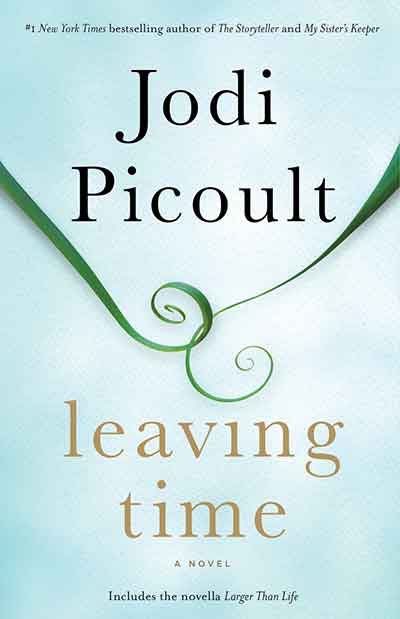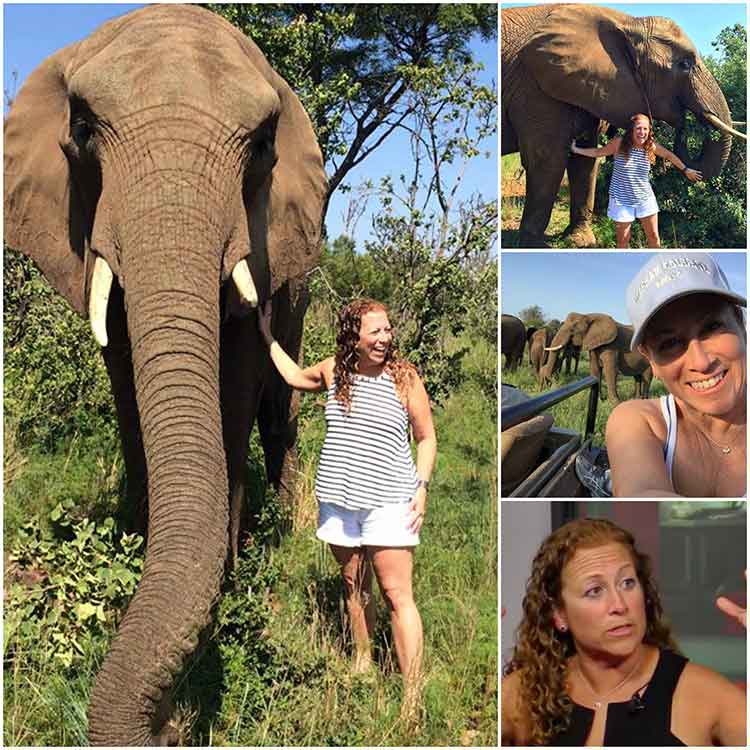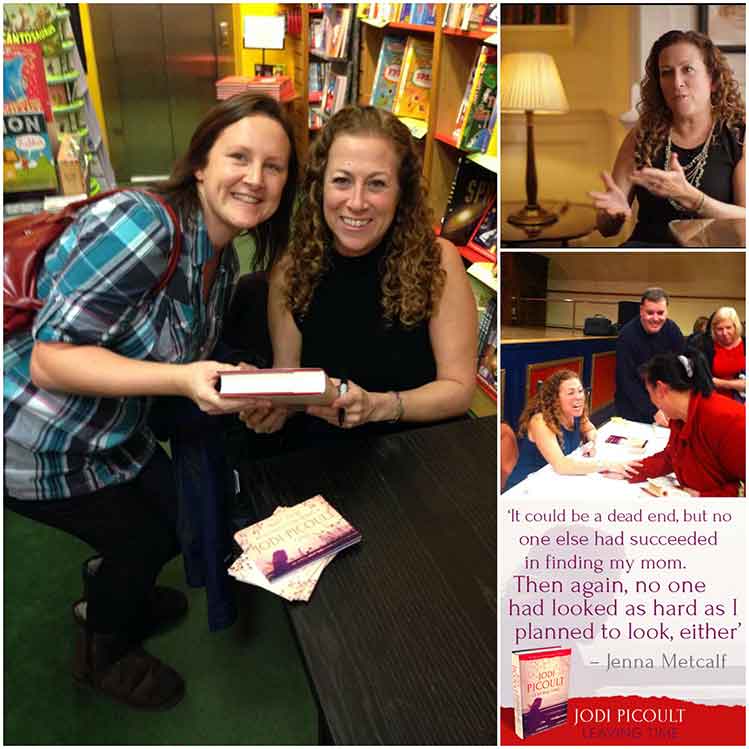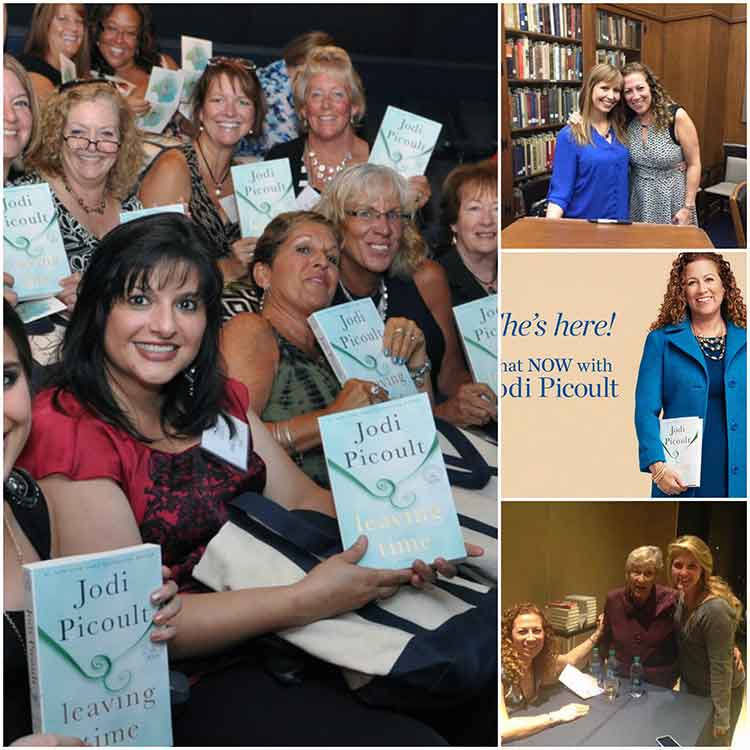
Now on sale in PAPERBACK! in US and the UK.
The paperback edition includes the novella “Larger than Life,” a Q&A with Jodi, and discussion questions. Book club, anyone?
Throughout her blockbuster career, #1 New York Times bestselling author Jodi Picoult has seamlessly blended nuanced characters, riveting plots, and rich prose, brilliantly creating stories that “not only provoke the mind but touch the flawed souls in all of us” (The Boston Globe). Now, in her highly anticipated new novel, she’s delivered her most affecting work yet —a book unlike anything she’s written before.
LEAVING TIME debuted as #1 NYT bestseller!
Jodi’s new novel, Leaving Time, was released in the US, Canada, and Australia October 14, 2014, and in the UK on 4th November. 13-year-old Jenna Metcalf is on a quest, searching for her mother, Alice, an elephant researcher, who disappeared 10 years earlier after a tragic accident at their sanctuary for former circus/zoo elephants in New England. Leaving Time explores the mother-daughter relationship, be it elephant or human, and the idea that those we can't forget are never truly gone. …more
A conversation with Jodi about Leaving TimeBest-selling, reliably entertaining, and thought-provoking Picoult's newest multifaceted novel is redolent with elephant lore that explores the animals' behavior when faced with death and grief, and combines a poignant tale of human loss with a perplexing crime story that delivers a powerhouse ending.
National Geographic Live!
Jodi discusses Leaving Time with Don George, National Geographic Editor-at-large. She describes personal experiences that helped shape the story, including her own familial relationships and her trip to Botswana, where she learned about the urgent crisis facing elephants.
My mother would never have left me behind, not willingly. If it's the last thing I do, I'm going to prove it.
The publisher: Ballantine Books, publication date: October 14, 2014
Paperback publication date: April 28, 2015; The paperback edition includes the novella Larger Than Life.
For more than a decade, Jenna Metcalf has never stopped thinking about her mother, Alice, who mysteriously disappeared in the wake of a tragic accident. Refusing to believe that she would be abandoned as a young child, Jenna searches for her mother regularly online and pores over the pages of Alice’s old journals. A scientist who studied grief among elephants, Alice wrote mostly of her research among the animals she loved, yet Jenna hopes the entries will provide a clue to her mother’s whereabouts.
Desperate to find the truth, Jenna enlists two unlikely allies in her quest. The first is Serenity Jones, a psychic who rose to fame finding missing persons—only to later doubt her gifts. The second is Virgil Stanhope, a jaded private detective who originally investigated Alice’s case along with the strange, possibly linked death of one of her colleagues. As the three work together to uncover what happened to Alice, they realize that in asking hard questions, they’ll have to face even harder answers.
As Jenna’s memories dovetail with the events in her mother’s journals, the story races to a mesmerizing finish. A deeply moving, gripping, and intelligent page-turner, Leaving Time is Jodi Picoult at the height of her powers.
.jpg)
Researching — with Professor Abigail Baird on the grounds of the Elephant Sanctuary in Hohenwald Tennessee.
I had the pleasure of spending time there with the caregivers and their “girls”. Both African and Asian elephants spend their days in their own respective habitats, "just being elephants". 2700 acres of wooded hills, valleys, ponds, creeks and a lake are available to these elephants, retired from circuses and zoos. Heated state-of-the-art barns are always open for their choosing. Enjoy watching these Big Girls dusting, napping, swimming and socializing with their friends.
Tune in to the Elecam stream to see the Girls and their daily activities! The focus is on the Elephant Sanctuary and its on-demand cam footage.
I’d urge any animal lovers to consider visiting elephants.com — the website for the Elephant Sanctuary in Hohenwald, Tennessee. In addition to watching live elecams (be careful, you will lose hours of valuable work time . . . ) you can “adopt” an elephant, or make a donation in memory of an animal lover, or feed all the elephants for one day —no amount is too small, and all are so greatly appreciated. Please also visit the Global Sanctuary for Elephants (globalelephants.org), which is helping establish holistic, natural elephant sanctuaries world-wide.
For those who would like to learn more about poaching and/or elephants in the wild, or to contribute to those fighting to get international restrictions in place to prevent it from happening, please visit:
The Billy and Kani Fund supports elephant recovery in Africa and Thailand, and fosters education about and conservation of elephants. Their mission is to restore space, peace and security for elephants and tribal communities.

Tusk asked Jodi a few questions about her experiences with elephants while researching for Leaving Time.
For research, I was I was privileged to first spend time at The Elephant Sanctuary in TN, meeting their elephants and learning what the caregivers do and how the sanctuary operates. I also went to Botswana and spent a week with a researcher, tracking herds in the wild, much like Alice does in the book. I learned to track elephants by footprint, to tell them apart, and to observe their behavior and mannerisms. I also gathered stories about evidence of elephant cognition and the unbreakable bond of elephant relationships. For example, the researcher I worked with found a male juvenile whose trunk was caught in a snare. He wouldn't survive without the trunk, so a decision was made to have the Wildlife Management folks euthanize him. The researcher drove the Wildlife Management worker to the elephant in a vehicle, but the worker was inexperienced and shot the elephant in the forehead instead of behind the ear. This left the elephant in even more pain, trumpeting. At that moment, a huge matriarch charged down the hill at the vehicle. This young male had been ejected from the herd already -- he was in his teens - but his mother heard his distress and came running all the same. She stood over him, like a mother stands over a small calf for protection, until he died. Another example occurred in Pilanesberg, SA, a reserve existed for elephants that were orphaned after culls for population control. It was a social experiment – they thought these teen elephants would bond into a herd, but that didn’t happen, because there was no matriarch. So a decision was made to bring two older females, Durga and Owalla, back to Africa from the US where they had been working and training. It was a success – the two matriarch formed two thriving herds. However, Owalla got bitten by a hippo 16 years later and couldn’t be anesthetized for medical reasons. They knew she was going to die, if not treated. So Randall Moore – Owalla’s former trainer –was called in. He found the herd, got out of his vehicle, and called Owalla by name. The younger members of the herd scattered, terrified of this human contact. Owalla came forward and greeted Randall, and then lifted her trunk and her leg according to his commands, letting the vets treat her without any anesthetic. After sixteen years of being completely wild, she remembered him, and his commands.
Elephants are among the few species in this world (including humans) that show cross-species empathy – they will help out another animal in distress even if there is no biological advantage. Their grieving rituals are remarkable too – an elephant will have a change in behavior if it comes across the bones of another elephant – getting quiet and reverential, and the tail and ears droop. Elephants will return to the site of a herd member’s death for years afterward, to stand quietly for a while before moving on. They have been known to break into research facilities and take bones of an elephant that are being used by a researcher, and to bring them back to the site of that elephant’s death. At The Elephant Sanctuary, I met Sissy, an elephant who survived the 1981 Gainesville Flood by being submerged for 24 hours with only her trunk above water. When she got to the sanctuary, she was traumatized and took to carrying around a tire, like a child’s security blanket. Eventually she bonded with an elephant named Tina and they were fast friends. But Tina died, and when she did, Sissy stayed with her – and then remained by her grave for a few days. Finally, she placed her tire on the grave – like a wreath – and left it behind, never to return to it – almost as if she believed Tina needed the comfort more, now.
Meeting these elephants in the wild and in sanctuaries really hammered home for me the damage done to elephants in captivity. The point of zoos was to develop breeding programs and more importantly to encourage conservation of animals that might not be indigenous to a country. However, the need for this has been reduced as the internet has developed. Any school kid, for example, can learn about elephants in Africa with a click. The zoo habitat is never large enough to accommodate an elephant. Moreover, elephants live in herds, so creating a "fake herd" of two of three elephants is much like throwing a human into a cell with a stranger and assuming they will be fast friends. 75% of elephants in North American zoos are overweight, 40% have foot or joint problems, and 80% have behavioral tics like head bobbing or swaying due to stress. For every elephant born in a zoo, another two die -- so even saying that zoos foster breeding programs is not quite accurate. Ideally, elephants should not be in zoos. Sanctuaries allow an elephant to live out the rest of its life in a habitat that is hundreds of acres, and to not be on display -- in sanctuaries, elephants set their time for coming and going. Of course, elephants in the wild are not thriving either. In Africa, 38,000 elephants are killed each year by poachers. Right now the estimate is that in ten years there will be no more African elephants. The price of an ounce of ivory has skyrocketed from $150 to $1300, due to demand from the far east (Southeast Asia and China). And lest you think poaching doesn't matter here in the US, every month 1-3 tons of ivory is poached by members of Al Shabaab, a terrorist group in Somalia with clear links to Al Quaeda. In order to save elephants, we need to continue to spread the word about poaching, as Tusk and the Clinton Global Initiative have done. The UN has created a resolution saying that poaching fuels instability in countries, and President Obama banned ivory trade in the US. This is all a good start. But in addition, the countries where poaching is the worst needs to offer their farmers an economic alternative to the one being offered by poachers. Local governments need to see that the cost of losing tourism will far exceed the immediate cash flow of poaching elephants, and need to create punishments for poachers that reflect this. At the same time, those who demand ivory need to be educated about the reality of poaching -- many believe that an elephant can regrow a tusk, which is not true; the only way to get an elephant tusk is to kill the elephant.
I have three kids, and my daughter – my youngest – was getting ready to go to college, which meant I’d be an empty nester. It was daunting, to say the least. Then I read that in the wild, an elephant mother and daughter stay together until one of them die. I thought, How enlightened! Why can’t we be like that!? I began to do a little digging on elephants, and when I discovered that they actually grieve and experience and process loss, I was completely hooked, and knew I would be writing about what it meant to be left behind…and also that I had my profession for the character of Alice.
Since becoming a fixture on bestseller lists eight years ago, every novel Jodi Picoult puts out has been touted as her “best one yet.” But this one might actually be her best one yet. It’s got everything you’d expect from Picoult: the impeccable pacing, the efficient prose, the expertly rendered characters, the brushstrokes of deep emotional brilliance, the carefully presented moral dilemmas. But somehow, Picoult has managed to do what she does so well with human characters – present them as a hodgepodge of flaws, quirks and strengths that give the reader no choice but to believe in their existence – with elephants, too. …As the narrative moves towards its unexpected and shockingly beautiful conclusion, Picoult presents a chronicle of the inner lives of a group of elephants and their ancestors that makes this book part breathless mystery, part exquisite love letter to a species that shares a surprising amount in common with humans, especially in the way they socialize, care for their young, and grieve their losses. Truly, this is Picoult at the top of her game.
Readers can usually count on blockbuster novelist Jodi Picoult for two things. First is a smart, accessible yarn with a suspenseful puzzle at its core that will keep readers enthusiastically turning the page. Second is impressive insight into any number of topical issues. From donor children and terminal illness to teen suicide and social issues like class and race, Picoult does her homework, and her main themes are thoroughly researched and engrossingly presented. With this new novel, “Leaving Time,” her fans will not be disappointed.
...the writing and storytelling compelled the suspension of disbelief and acceptance of the unimaginable. And in the end an amazed and admiring gasp—‘I did not see that coming.’
LEAVING TIME may be [Picoult’s] finest work yet and is sure to produce much discussion after reading it.
A truly engaging read. Perfect for Picoult fans and book clubs.
With plenty of twists and a surprising ending, [Leaving Time] explores the grieving process and what happens when we cannot move on.
Best-selling, reliably entertaining, and thought provoking Picoult’s newest multifaceted novel is redolent with elephant lore that explores the animals’ behavior when faced with death and grief, and combines a poignant tale of human loss with a perplexing crime story that delivers a powerhouse ending.
Picoult’s novel explores grief, memory, and motherhood through the unlikely lens of elephant behavior... The pachyderms are as complex as the humans, making the journey memorable and poignant.
Picoult writes with unassuming brilliance.
It’s hard to exaggerate how well Picoult writes.
Picoult is a master of the craft of storytelling.
…her storytelling skills are most evident.
I LOVE to meet my fans! xoxo —Jodi
A huge THANK YOU to all of my fans who come out to my Leaving Time tour!
South Africa: January 19–23









.jpg)
I started to write Leaving Time when I was in the process of becoming an empty-nester. My daughter Sammy was headed off to school. I was thinking a lot of how we humans raise our kids to be self sufficient enough to leave us – and how depressing it was for those who were left behind. That theme – of what happens to the people who are left behind – became what I wanted to write about. Then, I was reading something and learned that in the wild, an elephant mother and daughter stay together their whole lives until one of them dies. Given my frame of mind, it seemed so much more pleasant to do things the way elephants do. I began to dig a bit more about elephants, and their reaction to death, and what I uncovered became a metaphor for the novel.
For the character of Alice, who studies elephant cognition, I went first to a professor at Vassar – Abigail Baird – who taught me all about the brain and how memory works. Then, we ventured to Botswana to work with Jeanetta Selier, a Ph.D. researcher who studies herds in the Tuli block. You probably know a lot about elephants already – like the fact that they are the largest land mammals, 7-10K pounds. They’re herbivores. They are recognizable by tusks, hair, voice, and ears – elephant ears are as individual as human fingerprints. They live for 50-70 years in the wild, and adult females live in herds made of a matriarch – the oldest and biggest elephant – and two to ten females. Babies are allomothered, which means that they are cared for by all females in the herd, and older siblings get to practice their parenting skills before actually becoming moms. Male elephants are chased from the herd at about age 13 by the matriarch, when they first come into musth, a state where they get very aggressive and want to mate. They roam with small groups of males.
What you may NOT know about elephants is that they have an incredibly complex brain, capable of communicating, learning, remembering, and experiencing fear, pain and loss. In Kenya, there are two tribes that interact with the elephants frequently. The Masaai use spears to hunt them, and wear red. The Kamba are farmers who don’t hunt elephant. Scientists have proven that elephants can distinguish between the two groups by smell and sight. Herds showed greater fear when showed red garments – which suggests cognitive capacity and long term memory. Even elephants who had no direct experience with Masaai reacted this way, suggesting social learning and communication.
Joyce Poole, a famous elephant researcher, has done studies of empathy in elephants. She recounts how one elephant flinched when another reached toward an electric fence, even though the fence was inactive. There have been multiple reports of elephants helping to free rhino babies caught in a mud hole, although there is no evolutionary advantage to that behavior. They refuse to leave sick or injured elephants behind, even if the sick animal is not related to them.
The memory of an elephant? Turns out it’s a real thing. At the Elephant Sanctuary in TN, elephants reacted so badly to helicopters and planes that they had to institute a no fly zone overhead. The only helicopters most of these elephants would have ever encountered was 40-50 years prior, during the culls when they were captured and brought to the US.
The relationships of elephants last a lifetime. At The Elephant Sanctuary in TN, an elephant named Jenny was living peacefully when a new elephant, Shirley, arrived. When Shirley came into the barn that night, in the stall beside Jenny’s, Jenny began to pound at the bars between them, trying to get to Shirley. The caregivers eventually opened the gate between them and immediately Shirley and Jenny began to move in tandem – staying inseparable. When Jenny lay down to sleep, Shirley would straddle her, like a mother elephant would a calf. It turned out that when Jenny was a calf and Shirley was 30, they had both been at the same circus for a brief while. They had been separated for 22 years, but recognized each other. In Pilanesberg in S. Africa, there was a reserve for elephants who had been orphaned after culls for population control. But putting together a bunch of teen elephants didn’t work, and two matriarchs were brought over from the US, where they had been trained and living. Sixteen years passed, and these two matriarchs managed to whip the teen elephants into herd formation, going without human contact for 16 years. Then, one of the elephants, Owalla, was bitten by a hippo. For medical reasons she couldn’t be sedated and researchers knew she would die if not treated. Worse, if she died, the fragile herd would likely fall apart again. Desperate, they reached out to Randall Moore – the original trainer of Owalla, who had not seen her for over a decade. He flew to Pilanesberg, got out of his vehicle, and called Owalla’s name. While her herd ran away, terrified, Owalla greeted Randall, following his commands to lift her trunk and stay still so she could be treated by a vet without anesthetic.
Elephants have elaborate rituals of grief, much like humans. If an elephant comes across the bones of another elephant, it will be quiet and reverential. The tail and ears will droop. They will pick up the bones and roll them beneath their hind feet. They only do this with elephant bones, not the bones of other animals. They will return to the spot of a herd member’s passing and pay respects for years to come. They will often cover an elephant who dies with branches and dirt. They’ve been known to break into research camps to steal a bone a scientist is working with, and to return it to the spot of that elephant’s demise. But the most lovely story of grief I learned came from the Elephant Sanctuary. An elephant named Sissy survived the 1981 Gainesville flood and was brought, traumatized, to the Sanctuary. She took to carrying a tire around, like a pacifier. After a while, she befriended another elephant there named Tina. When Tina died, Sissy stayed at her grave for a day. Then, she lay her tire down on her best friend’s grave, like a wreath, and left – almost as if she knew that Tina was the one who needed comfort, now.
If you learn this much about elephants, you can’t NOT be moved by their plight in both captivity and the wild. The point of zoos was to develop breeding programs and more importantly to encourage conservation of animals that might not be indigenous to a country. However, the need for this has been reduced as the internet has developed. Any school kid, for example, can learn about elephants in Africa with a click. Elephants suffer greatly in captivity. The zoo habitat is never large enough to accommodate an elephant. Moreover, elephants live in herds, so creating a "fake herd" of two of three elephants is much like throwing a human into a cell with a stranger and assuming they will be fast friends. 75% of elephants in North American zoos are overweight, 40% have foot or joint problems, and 80% have behavioral tics like head bobbing or swaying due to stress. For every elephant born in a zoo, another two die -- so even saying that zoos foster breeding programs is not quite accurate. Ideally, elephants should not be in zoos. Sanctuaries allow an elephant to live out the rest of its life in a habitat that is hundreds of acres, and to not be on display -- in sanctuaries, elephants set their time for coming and going.
Of course, elephants in the wild are not thriving either. In Africa, 38K elephants are killed each year by poachers. The first hint that a population is being poached is a disparity between females and males – because poachers go for the biggest tusks. Once all the males are gone, the poachers go after the matriarchs – but the collateral damage of losing a matriarch is huge. If a matriarch dies, so does the collective knowledge of that family, and the society disintegrates. The herd won’t know where the best water holes are, in times of drought. They won’t know the safest travel corridors. Any nursing babies die if their mothers are killed. Right now the estimate is that in ten years there will be no more African elephants.
But poaching isn’t just a wildlife crisis – it’s a humanitarian concern. The price of an ounce of ivory has skyrocketed from $150 to $1300, due to demand from the Far East (Southeast Asia and China). Money from poaching fuels instability in Democratic African Republic, and there are rumors that Joseph Kony’s Lord’s Resistance Army was funded with the proceeds of illegal ivory from the Democratic Republic of Congo. And lest you think poaching doesn't matter here in the US, every month 1-3 tons of ivory is poached by members of Al Shabaab, a terrorist group in Somalia with clear links to Al Quaeda.
So how do we save these magnificent, intelligent animals? We need to continue to spread the word about poaching, as Tusk and the Clinton Global Initiative have done. The UN has created a resolution saying that poaching fuels instability in countries, and President Obama banned ivory trade in the US. China even destroyed stores of illegal ivory, crushing it, which set a great example. This is all a good start. But in addition, the countries where poaching is the worst needs to offer their farmers an economic alternative to the one being offered by poachers. Local governments need to see that the cost of losing tourism will far exceed the immediate cash flow of poaching elephants, and need to create punishments for poachers that reflect this. At the same time, those who demand ivory need to be educated about the reality of poaching -- many believe that an elephant can regrow a tusk, which is not true; the only way to get an elephant tusk is to kill the elephant. Here in the US, if you are concerned about elephants, donate time and money to an accredited anti-poaching organization. And write your congressional representatives and tell them to support the presidential initiative against poaching. Because I promise you – once you read LEAVING TIME, you’re never going to think about elephants quite the same way.
Some people used to believe that there was an elephant graveyard—a place that sick and old elephants would travel to die. They’d slip away from their herds and would lumber across the dusty landscape, like the titans we read about in seventh grade in Greek Mythology. Legend said the spot was in Saudi Arabia; that it was the source of a supernatural force; that it contained a book of spells to bring about world peace.
Explorers who went in search of the graveyard would follow dying elephants for weeks, only to realize they’d been led in circles. Some of these voyagers disappeared completely. Some could not remember what they had seen, and not a single explorer who claimed to find the graveyard could ever locate it again.
Here’s why: The elephant graveyard is a myth.
True, researchers have found groups of elephants that died in the same vicinity, many over a short period of time. My mother, Alice, would have said there’s a perfectly logical reason for a mass burial site: a group of elephants who died all at once due to lack of food or water; a slaughter by ivory hunters. It’s even possible that the strong winds in Africa could blow a scattering of bones into a concentrated pile. Jenna, she would have told me, there’s an explanation for everything you see.
There is plenty of information about elephants and death that are not fables, but instead cold, hard science. My mother would have been able to tell me that, too. We would have sat, shoulder to shoulder, beneath the massive oak where Maura liked to shade herself, watching the elephant pick up acorns with her trunk and pitch them. My mother would rate each toss like an Olympic judge. 8.5 . . . 7.9. Ooh! A perfect 10.
Maybe I would have listened. But maybe, too, I would have just closed my eyes. Maybe I would have tried to memorize the smell of bug spray on my mother’s skin, or the way she absent-mindedly braided my hair, tying it off on the end with a stalk of green grass.
Maybe the whole time I would have been wishing there really was an elephant graveyard, except not just for elephants. Because then I’d be able to find her.
When I was nine—before I grew up and became a scientist—I thought I knew everything, or at least I wanted to know everything, and in my mind there was no difference between the two. At that age, I was obsessed with animals. I knew that a group of tigers was called a “streak.” I knew that dolphins were carnivores. I knew that giraffes had four stomachs and that the leg muscles of a locust were 1000 times more powerful than the same weight of human muscle. I knew that white polar bears had black skin beneath their fur, and that jellyfish have no brains. I knew all these facts from the Time-Life monthly animal fact cards that I had received as a birthday gift from my father, who had moved out a year ago and now lived in San Francisco with his best friend Frank, who my mother called “the other woman” when she thought I wasn’t listening.
Every month new cards arrived in the mail, and then one day, in October of 1977, the best card of all arrived: the one about elephants. I cannot tell you why they were my favorite animal. Maybe it was my bedroom, with its green shag jungle carpet and the wallpaper border of cartoon pachyderms dancing across the walls. Maybe it was the fact that the first movie I’d ever seen, as a toddler, was Dumbo. Maybe it was because the silk lining inside my mother’s fur coat, the one she had inherited from her own mother, was made from an Indian sari and printed with elephants.
From that Time-Life card, I learned the basics about elephants. They were the largest land animals on the planet, sometimes weighing more than six tons. They ate 300-400 pounds of food each day. They had the longest pregnancy of any land mammal—22 months. They lived in breeding herds, led by a female matriarch, often the oldest member of the group. She was the one who decided where the group went every day, when they took a rest, where they ate and where they drank. Babies were raised and protected by all the female relatives in the herd, and traveled with them, but when males were about thirteen years old, they left—sometimes preferring to wander on their own, and sometimes gathering with other males in a bull group.
But those were facts that everyone knew. I, on the other hand, became obsessed and dug a little deeper, trying to find out everything I could at the school library and from my teachers and books. So I also could tell you that elephants got sunburned, which is why they would toss dirt on their backs and roll in the mud. Their closest living relative was the rock hyrax, a tiny furry thing that looked like a guinea pig. I knew that just like a human baby sucks its thumb to calm itself down, an elephant calf might sometimes suck its trunk. I knew that in 1916, in Erwin, Tennessee, an elephant named Mary was tried and hanged for murder.
In retrospect I am sure my mother got tired of hearing about elephants. Maybe that is why, one Saturday morning, she woke me before the sun came up and told me we were going on an adventure. There were no zoos near where we lived in Connecticut, but the Forest Park Zoo in Springfield, Massachusetts had a real, live elephant—and we were going to see her.
To say I was excited was an understatement. I peppered my mother with elephant jokes for hours:
What’s beautiful, gray, and wears glass slippers? Cinderelephant.
Why are elephants wrinkled? They don’t fit on the ironing board.
How do you get down from an elephant? You don’t. You get down from a goose.
Why do elephants have trunks? Because they’d look funny with glove compartments.
When we got to the zoo, I raced along the paths until I found myself standing in front of Morganetta the elephant.
Who looked nothing like what I had imagined.
This was not the majestic animal featured on my Time-Life card, or in the books I had studied. For one thing, she was chained to a giant cement block in the center, so that she couldn’t walk very far in any direction. There were sores on her hind legs from the shackles. She was missing an eye, and with her other, she wouldn’t look at me. I was just another person who had come to stare at her, in her prison.
My mother was stunned by her condition, too. She flagged down a zookeeper, who said that Morganetta had once been in local parades, and had done stunts like competing against undergrads in a tug-o’-war at a nearby school, but that she had gotten unpredictable and violent in her old age. She’d lashed out at visitors with her trunk if they came too close to her cage. She had broken a caretaker’s wrist.
I started to cry.
My mother bundled me back to the car for the four hour drive home, although we had only been at the zoo for ten minutes.
“Can’t we help her?” I asked.
This is how, at age nine, I became an elephant advocate. After a trip to the library, I sat down at my kitchen table, and I wrote to the mayor of Springfield, MA, asking him to give Morganetta more space, and more freedom.
He didn’t just write me back. He sent his response in the Boston Globe, who published it, and then a reporter called to do a story on the nine-year-old who had convinced the mayor to move Morganetta into the much larger buffalo enclosure at the zoo. I was given a special Concerned Citizen award at my elementary school assembly. I was invited back for the grand opening to cut the red ribbon with the mayor. Flash bulbs went off in my face, blinding me, as Morganetta roamed behind us. This time, she looked at me with her good eye. And I knew, I just knew, she was still miserable. The things that had happened to her—the chains and the shackles, the cage and the beatings, maybe even the memory of the moment she was taken out of a forest somewhere in Africa—all that was still with her in that buffalo enclosure, and it took up all the extra space.
For the record, Mayor Dimauro did continue to try to make life better for Morganetta. In 1979, after the demise of Forest Park’s resident polar bear, the facility closed and Morganetta was moved to the Los Angeles Zoo. Her home there was much bigger. It had a pool, and toys, and two older elephants.
If I knew back then what I know now, I could have told the mayor that just because you stick an elephant in proximity with others does not mean they will form friendships. They are as unique in their personalities as humans are, and just as you would not assume that two random humans would become close friends, you should not assume that two elephants will bond simply because they are both elephants. Morganetta continued to spiral deeper into depression, losing weight and deteriorating. Approximately one year after she arrived in LA, she was found dead in the bottom of the enclosure’s pool.
The moral of this story is that sometimes, you can attempt to make all the difference in the world, and it still is like trying to stem the tide with a sieve.
The moral of this story is that no matter how much we try, no matter how much we want it . . . some stories just don’t have a happy ending.